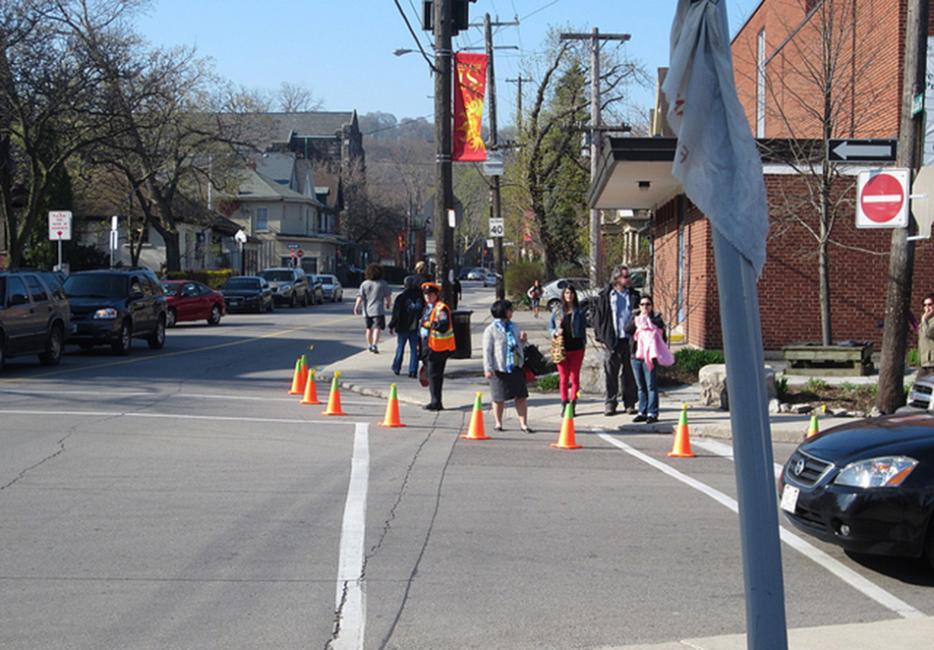The intersection of Locke and Herkimer streets in Hamilton could be any of a hundred intersections in the city, any of a thousand in my town or yours. Locke runs north to south, the tidy prewar residential blocks south of Herkimer giving way to a strip of trendy new retail to the north—a locavore café, a flower shop. Herkimer runs west to east, pointed like an arrow from Hamilton’s far flung suburbs to its anemic downtown core, the traffic moving one way only. On the northeast corner, there is a lovely old church. On the southwest, an elementary school, St. Joseph, tight to the intersection in the style of pre-suburban street design everywhere.
The intersection of Locke and Herkimer is a four-way stop, and by rights it should be a quiet little residential intersection. But like a lot of Hamilton and most of North America, the intersection became, over the years, an obstacle in the relentless rush of commuter traffic. The cars came from the north and west in the morning and roared back out in the evening, and the intersection became a hurried, dangerous place where 4,000-pound steel projectiles came to impatient stops and rolled sloppily over the faded perpendicular lines on the dusty asphalt that indicated the space where people on foot presumed to have the right of way.
The intersection, nominally a downtown street corner, was one of a hundred or a thousand speed bumps on a daily commute that treated all such obstacles between the beginning and end of the journey as the sovereign territory of the automobile.
And then, in the black predawn of May 1, 2013, there arrived at the intersection of Locke and Herkimer a counter-claim, an insurrection, a sort of coup. A small platoon from the Hamilton-Burlington Society of Architects descended on the scene. They were led by two HBSA rabble-rousers named Philip Toms and Graham McNally, and they came armed with a cordless power drill and a bright new idea called “tactical urbanism.” By the time the sun rose on Locke and Herkimer that morning, the insurrectionaries had completed a modest, unsanctioned redesign of the intersection. At the northeast and southwest corners abutting the church and school, respectively, the rounded sidewalks had been extended out into the roadway by way of a curved arc of orange traffic cones. They were bolted to the asphalt, which might’ve given the adjustment an air of permanence and official consent if not for the whimsical orange flowers set atop each one. In urban design parlance, these were “bump-outs,” one of an array of tools by which the dismal applied science of “traffic calming” is accomplished. They added just a few square metres to the pedestrian’s territory at Locke and Herkimer, but it was enough to narrow the roadway and provide sufficient room for the flocks of schoolchildren who traversed the intersection daily to stand and wait for a safe moment.
An intrepid local blogger, Ryan McGreal of Raise the Hammer, arrived on the scene a few days later and asked the incorruptible St. Joseph School crossing guard what she thought. “I like it!” she replied, because it “really controls the traffic. It was getting scary.” The quote was widely disseminated in the outsized citywide uproar the bump-outs had inspired.
We’ll come back to all that. The point, for now, is this: a handful of concerned citizens, fed up with years of bureaucratic footdragging, took the bylaw into their own hands and made an intersection safer for schoolchildren. And in Hamilton, Ontario, in 2013, this was a wildly controversial thing to do.
*
Actually, unauthorized urban redesign is pretty controversial in lots of places, which is why it was obliged to organize itself into a movement under the banner of tactical urbanism in the first place. Credit for the name and a great deal of the dissemination of the concept belongs to Mike Lydon, an urban planner and principal at the Brooklyn-based firm Street Plans Collaborative. Inspired by the literal overnight transformations of New York streets and plazas in recent years under the city’s crusading transportation commissioner, Janette Sadik-Khan, Lydon assembled a catalogue of quick, easy, temporary urban design tools, referred to them collectively as “tactical urbanism,” and posted a free guide to the new practice online. Lydon spoke of pop-up cafes, temporary bump-outs and part-time street furniture, parallel parking spots turned into “parklets,” food trucks and guerilla bike lanes, and “better block” projects disguised as art installations. Taken together, he saw these as the rising crest of a new wave in smart, quick, cheap, pragmatic urban design, a youthful wave of here-and-now results-obsessed city building to combat the endless debates and committee hearings that paralyzed so many city halls.
By and by, Lydon appeared in an online video talking up the concept, and it came to the attention of Graham McNally, a young Hamilton architect. McNally was looking to do something out of the ordinary for Doors Open Hamilton, an annual celebration of the city’s best urban structures. In previous years, there’d been a keynote lecture sponsored by HBSA, but McNally decided the 2013 edition would also include a design charette, something to shake things up and get something happening on the street.
It warrants mention here that even in the rather dismal annals of postwar North American urban design and civic governance, Hamilton’s a notable laggard. Many of its downtown thoroughfares—including the one actually called “Main Street”—are one-way high-speed quasi-freeways, hurrying commuter traffic past bingo halls and tattoo parlours. Its landmark downtown hotel, the Royal Connaught, has been boarded up for nine years. Not long ago, when a funky new hole-in-the-wall Mexican joint popped up on the periphery of Hamilton’s signature downtown square, city officials attacked it mercilessly for failing to adhere to some obscure diktat of the “Downtown Heritage Character Zone,” which obliged a mandatory minimum percentage of glass covering the street façade. In Hamilton, “Heritage Character” prefers a boarded-up window to an active retail space behind an insufficient portion of glass. To be an urbanist in such a place is to embrace a certain kind of maddening stasis.
“There seemed to be increasing frustration,” Graham McNally told me. “You know, we’re talking about complete streets, we’re talking about walkability, but nothing’s actually happening.”
McNally and his colleagues were determined that the HSBA’s design charette would break the pattern. It was scheduled for April 19. Mike Lydon arrived a day early and attended the monthly HSBA meeting, at which a desperate call went out. Whatever came of the charette, something had to actually happen in Hamilton. McNally: “We came up with basically a brainstorming session, looking at, okay, what could you do if you had no budget?” By the end of the HSBA meeting, they had slightly more than that: $5,000 in donations and a commitment to action.
The next day at the charette, Lydon walked the audience through a handful of simple, inexpensive ways the city’s intersections could be reconfigured to make them work better for people as well as cars. Two weeks later, in the early morning of May 1, a team of newly deputized tactical urbanists, led by McNally and Philip Toms, installed the bumpouts at Locke and Herkimer.11A lesson learned at Locke and Herkimer: bolting pylons to asphalt is not an entirely straightforward process. McNally: “Phil went to the hardware store and got self-tappers and, like, three or four different types of screws.” Philip Toms: “Some of them sheared off and some of them didn’t have a rough enough tooth to actually sort of pull them in. Some of them had thread all the way the whole length, so you had too much resistance. You want something that once it’s got tooth, the shaft of the screw has actually got no thread, so it’s pulling in but not resisting. There’s a science to screws and fasteners which is actually a very, very deep science.
Chaos did not ensue at Locke and Herkimer, but it soon reigned at City Hall. Six days after the HSBA made its interventions, one Gerry Davis, the general manager of Public Works, sent an urgent memo to the entirety of Hamilton City Council and all its senior managers and top bureaucrats. He’d surveyed the tactical urbanists’ work—which included a new crosswalk on a busy suburban thoroughfare as well as the bump-outs—and was righteously peeved. Here’s Davis’ opening summary: “These changes to City streets are illegal, potentially unsafe and adding to the City's costs of maintenance and repair. The City can consider this as vandalism, with the potential for serious health and safety consequences for citizens, particularly pedestrians.”
The pylons were duly removed, the unsanctioned crosswalk pressure-sprayed into oblivion. But the memo made its way to McNally and Toms, who wisely responded by sending copies of Lydon’s Tactical Urbanism Vol. 2 to every councillor ahead of the next council meeting. Toms: “When they were told about this bad, bad, naughty thing that happened, they could look and see, you know, what exciting stuff it actually is part of.”
What happened next was both predicted and wholly unexpected. It was the kind of thing tactical urbanists like Lydon talk about as the sort of Platonic ideal arc of an intervention, a cave-wall shadow rarely seen in broad daylight. The City of Hamilton—part of it, anyway—saw the light. The intersection of Locke and Herkimer resides in the ward of Councillor Brian McHattie, and he loved the bump-outs. So did the city’s director of corporate assets, former traffic engineer John Mater. Councillors have discretionary budgets for certain kinds of “pilot project,” and the intersection of Locke and Herkimer was chosen as the site for such a sanctioned intervention. By late June, when I visited with McNally and Toms, the intersection had been reconfigured even more ambitiously than before.
At Locke and Herkimer today, high-visibility white bollards trace semi-circular bump-outs wider than the ones installed by the tactical urbanists. (You can still see traces of their original arcs in faded dots of green paint on the asphalt.) A thick white stripe of paint reinforces the barrier, and thick zebra stripes mark all four pedestrian crossings. “It’s so much more sedate,” McNally told me. “These collections of twelve kids actually have somewhere to stand.”
We were standing at the southwest corner, nearest to the school. As if on cue, a teacher and a gaggle of St. Joseph students assembled at the far corner in front of the church. We watched as they waited on traffic and then casually navigated the two crossings and ambled past us to reach the school’s doors. Philip Toms pointed out that there’d been something like six years of discussion about the sidewalks and playgrounds around the school. One of the reasons they’d chosen Locke and Herkimer for their intervention was that Toms had spent around 150 hours of his professional time working on it in vain. The bump-outs were merely one piece of that puzzle, but they’d come to pass as a result of just a couple hours’ work on a single spring night.
*
One of the tenets of tactical urbanism is that it is strategic. It is not an art installation or a stunt. It has motives and goals. Ideally, the intervention becomes a catalyst.
Toms and McNally and the HSBA are now working formally with the City of Hamilton on intersection design. They’ve been asked to identify other sites around the city where bumpouts and real crosswalks might make a difference. They’re building a website where Hamiltonians can collaborate to identify the best spots. They’d like to see one a week until 150 intersections have been redesigned with people in mind.
“It’s possible,” McNally told me, “ that things might have actually changed. To just kickstart it, it resonated with people, because it was about doing, not talking about it.” He digressed, digging back through the morass of consultation and debate that had gone into changing one downtown thoroughfare from one-way back to two-way traffic. The subtext, unspoken, is that there was still an enormous pile of bureaucratic muck to move.
“It’s pretty easy to get people excited about these ideas,” Toms said, bringing him back to the intersection of Locke and Herkimer, where change had been measured in hours and days. Like in a story of divine intervention, so it seemed.
McNally conceded the point. “When you think you can actually have an effect on the city and make it better, people get excited, right?”





